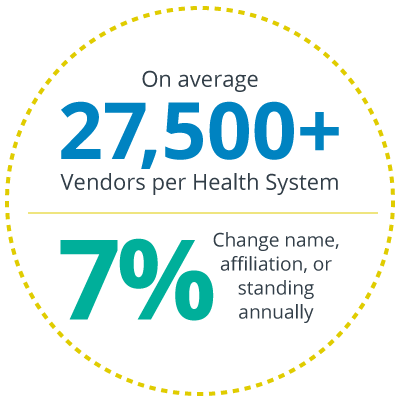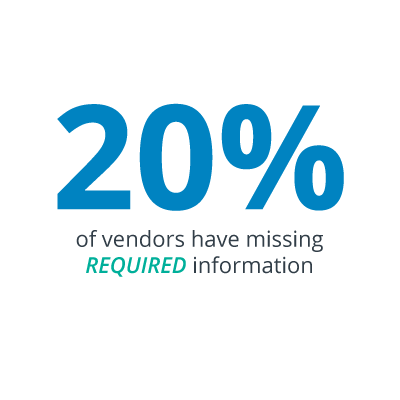
On average, health systems work with over 27,500 vendors at a given time with seven percent of those vendors changing their name, affiliation, or standing on an annual basis. With such a large number and variability of vendors, managing vendor data can quickly become cumbersome for an organization’s Accounts Payable (AP) department creating exposure to payment errors, fraudulent charges, and risk of noncompliance.
To minimize these risks, AP departments or the parties responsible for the vendor master must keep their master file current and free of errors by performing a vendor master cleanse and maintain the file on a quarterly basis.
Top Five Reasons to Cleanse Vendor Master Files
1. Reduce the Risk of Payment Errors
Keeping clean data in vendor masters help prevent payment errors such as duplicate payments and potentially missing rebates/discounts. One main cause of duplicate payments is the existence of duplicate vendors in a health system’s ERP. Based on TAG’s clients in 2018, 25 percent of all duplicate payments were made because of varying company names in their ERP representing the same vendor.
Cleansing also reduces the risk of payments made to fraudulent vendors that may have “snuck” their way into a vendor file. This may happen through staff knowingly entering fraudulent vendors into the system on the procurement side or an unsuspecting AP clerk rushing to catch up on payments by quickly creating a new vendor record to pay an invoice. Either way, a thorough vendor master cleanse would verify and validate each vendor’s credentials including their contact information and tax ID exploiting fake vendors.
2. Identify Incomplete Data
 Performing a vendor master cleanse makes it easy to spot any missing vendor information and allows an organization’s team to update each supplier’s data. On average, TAG, Inc. finds its clients have an average of 20 percent of vendors with missing required information when receiving vendor data for health systems. Ensuring vendor data is complete is essential for AP departments to pay within terms and take advantage of rebates and discounts.
Performing a vendor master cleanse makes it easy to spot any missing vendor information and allows an organization’s team to update each supplier’s data. On average, TAG, Inc. finds its clients have an average of 20 percent of vendors with missing required information when receiving vendor data for health systems. Ensuring vendor data is complete is essential for AP departments to pay within terms and take advantage of rebates and discounts.
This also gives AP staff the opportunity to input missing data that may be required or helpful in managing suppliers in the future. For example, if a company changes its billing address or offers new cash discounts, a note should be made in their file. If a note is not taken, this information may get lost when employees leave their roles.
Check back to our blog soon to learn the process of cleansing a vendor master.
3. Strengthen Vendor Relationships
An accurate vendor master file allows health systems to remain in good standing by confirming correct contract terms are abided by, but it also helps to maintain relationships. A strong supplier relationship helps improve and speed up correspondence with vendors that in turn help with requests such as statement collection.
Strong vendor relationships are also favorable when it comes time to renegotiate contracts with lower pricing and not being placed on credit hold.
4. Stay Compliant
Cleansing a vendor master file ensures that organizations are not using the Office of Inspection General (OIG) excluded vendors. This list, which adds and deletes vendors on a daily basis, is available free on the OIG’s website. The list excludes individuals and entities from Federally funded healthcare programs to protect both patients and hospitals. Learn more about vendor compliance guidelines here. TAG recommends that health systems compare active vendors against this list quarterly.
A complete and accurate vendor master also helps hospitals stay compliant with government programs by tracking and meeting supplier requirements such as diversity. It also helps health systems stay compliant with the contracts agreed upon with their suppliers such as meeting minimum purchasing requirements.
5. Report with Accuracy
Vendor masters help to record charges for federal and state taxes each year by storing data such as IRS-1099s. It also allows organizations to better understand their spend allowing for future vendor contract negotiation and fiscal forecasting.
An accurate and correct vendor master file helps hospitals and health systems report on more than simply financial activity. As mentioned before, it helps track expenditures on metrics such as diversity and inclusion allowing them to take advantage of government programs and track rebates.
Vendor Master Maintenance
Understanding the need and benefits of performing a vendor master cleanse is essential, but the task of executing a cleanse can quickly drain internal resources.
Consider the fact that seven percent of vendors change their name, affiliation, or standing on an annual basis and an average health system has over 27,500 vendors, leaving 2,000 vendors with data that needs to be adjusted each year. This breaks down to updating seven vendors each working day. If it takes an average of 30 minutes to update each vendor file, organizations lose half of an FTE’s total time. If clerks are earning an average of $38,000 each year, organizations would spend roughly $19,000 annually to simply maintain vendor data excluding benefit costs.
Can your team afford to lose these resources?
Most health systems, cannot lose the already limited time of their clerks. That’s where TAG comes in by taking a system’s vendor master and accompanying documents to perform a master cleanse allowing clients to simply focus on maintenance moving forward. TAG recommends that clients perform a vendor mast cleanse every three years or during a major organizational event such as a merger or ERP conversion.
Between master cleanses TAG also suggests that clients review the data of any new vendors on a quarterly basis to maintain their vendor database or utilize TAG’s cleansing and maintenance services.
Want to learn more about our vendor or item master cleanse? Send us a message now.
